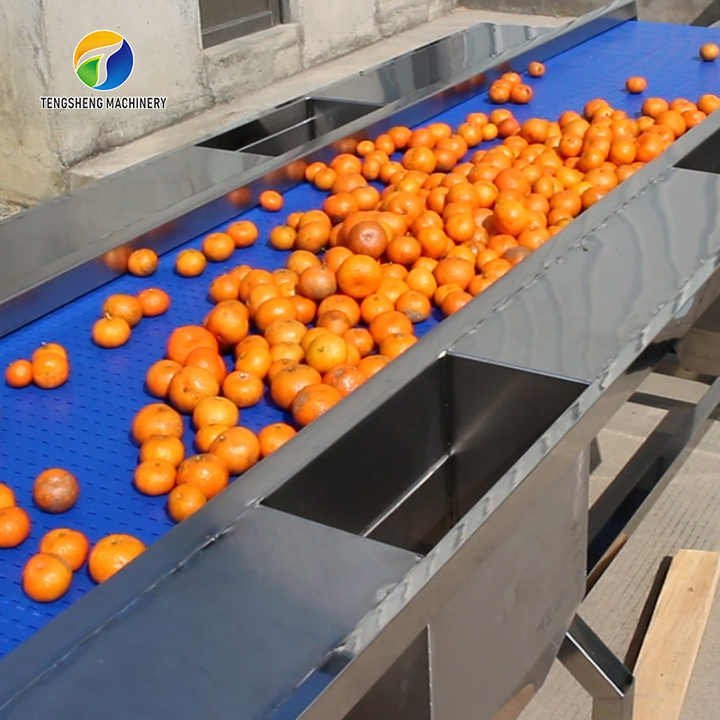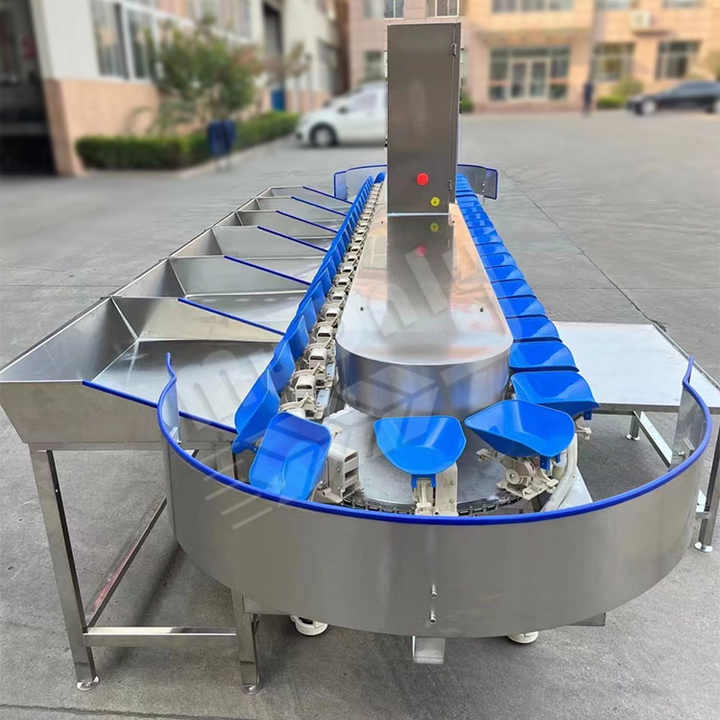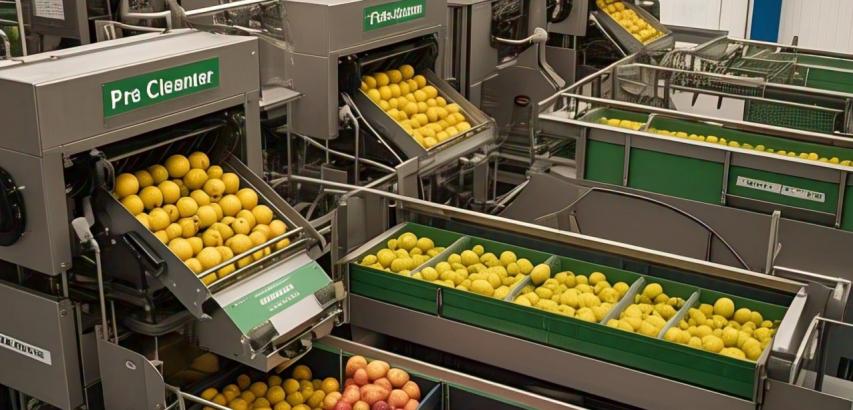Fruit size grading and sorting machines are specialized agricultural or post-harvest equipment designed to automatically separate fruits into uniform size categories based on their diameter or, sometimes, length or weight. This process is crucial for meeting market standards, optimizing packing, ensuring consistent quality, and maximizing the economic value of the harvest.
Why Size Grading Matters:
Market Requirements: Retailers and consumers demand uniformity in fruit size for visual appeal and consistent portioning.
Pricing & Value: Larger fruits often command higher prices. Precise sorting ensures fair pricing based on size class.
Packing Efficiency: Uniform sizes fit better into standardized packaging (clamshells, boxes, trays), preventing damage and maximizing space utilization.
Processing: Consistent size is vital for automated processing lines (peeling, coring, slicing, dicing).
Quality Perception: Uniform size signals quality and professionalism to buyers.
Labor Reduction: Automates a tedious, time-consuming, and often inconsistent manual task.
How Fruit Size Grading/Sorting Machines Work:
The core principle involves measuring each fruit's dimension(s) and physically diverting it into the correct output lane or bin based on predefined size ranges. Here are the primary methods:
Mechanical Roller/Cup Sizers (Most Common for Round Fruits):
Principle: Fruits move along diverging rollers or through progressively larger cups/channels.
Process: As the gap between rollers increases or the cup size changes, fruits fall through when the gap/cup matches their diameter. Smaller fruits drop first into one lane, medium next, largest last.
Pros: Simple, robust, low maintenance, relatively inexpensive, high throughput, no complex electronics. Ideal for apples, oranges, peaches, potatoes, tomatoes, onions.
Cons: Less precise for irregular shapes, potential for bruising if not designed well, limited to diameter sorting, difficult to change size classes quickly.
Weight-Based Sorters:
Principle: Fruits are individually weighed on sensitive load cells as they pass.
Process: Based on the measured weight, the machine uses paddles, belts, or drops to divert the fruit into the appropriate weight class lane.
Pros: Highly accurate, excellent for irregularly shaped fruits (mangoes, avocados, pears) or where density matters, easy to reconfigure size classes (via software).
Cons: Generally slower throughput than mechanical sorters, higher initial cost, more complex electronics, requires careful calibration.
Optical Size Grading (Machine Vision):
Principle: Cameras capture images of each fruit from multiple angles.
Process: Sophisticated software analyzes the images to calculate precise dimensions (diameter, length, width, even volume), often along with color and defects. Sorting is done via air jets, paddles, or belts.
Pros: Highly accurate and precise, can measure multiple dimensions simultaneously, non-contact (minimizes damage), integrates easily with color/defect sorting, flexible size class definition via software.
Cons: Highest initial cost, requires stable lighting and clean optics, more complex setup and maintenance, potential for higher computational demands.
Key Components of a Size Sorter:
Infeed System: Gently feeds fruit onto the sorting mechanism (e.g., vibrating table, conveyor with singulators).
Singulation System: Crucial step ensuring fruits are separated and presented individually for accurate measurement (rollers, belts, flumes).
Sizing Mechanism: Rollers, cups, weigh cells, or camera stations.
Control System: Electronics and software that interpret measurements and control sorting actuators.
Sorting/Diversion Mechanism: Paddles, air jets, tilting trays, drop chutes, or belt diverters that physically move the fruit to the correct output lane.
Output Lanes/Bins: Collection points for the different size grades.
User Interface (HMI): Screen for operators to set parameters, monitor performance, and diagnose issues.
Benefits of Automated Size Grading/Sorting:
Increased Efficiency & Throughput: Processes fruit much faster than manual sorting.
Improved Accuracy & Consistency: Eliminates human error and subjectivity in sizing.
Enhanced Fruit Quality: Gentle handling systems minimize bruising and damage.
Higher Profitability: Maximizes value by accurately sorting into premium size classes, reduces labor costs, minimizes packing waste.
Data Collection: Modern machines can log data on size distribution, throughput, and potential issues.
Traceability: Size grades can be linked to batches or sources.
Labor Savings: Reduces reliance on large manual sorting crews.
Considerations When Choosing a Machine:
Fruit Type & Characteristics: Shape (round, oval, irregular), size range, fragility, surface texture (waxy, fuzzy).
Required Throughput (Capacity): Kilograms or tons per hour.
Desired Precision: How tight do the size classes need to be? (e.g., 2mm increments vs. 5mm).
Sorting Criteria Needed: Only size, or also weight, color, defects?
Integration: Does it need to fit into an existing packing line? Conveyor height/width compatibility.
Durability & Maintenance: Harsh washdown environments require robust, food-grade materials. Ease of cleaning and access for maintenance.
Flexibility: How easy is it to change size classes? Is it used for multiple fruit types?
Budget: Mechanical sorters are most affordable, optical sorters are a significant investment.
Available Space: Machine footprint.
Emerging Trends:
AI & Advanced Machine Vision: Improved shape recognition, handling of irregular fruits, better defect detection alongside sizing.
Multi-Sensor Integration: Combining size data with internal quality sensors (NIR for sweetness, dry matter, internal defects).
Robotics: Robotic arms for gentle handling and precise placement.
Data Analytics & Cloud Connectivity: Real-time monitoring, predictive maintenance, yield optimization insights.
Applications Beyond Fruit:
While designed for fruit, these principles apply to sorting many other agricultural products by size: vegetables (potatoes, onions, tomatoes), nuts, eggs, potatoes.
Fruit size grading and sorting machines are indispensable tools for modern fruit packers and processors. They transform a variable natural product into uniform, marketable lots, ensuring quality, maximizing value, and improving operational efficiency. From simple mechanical roller sorters handling high volumes of round fruits to sophisticated optical systems providing multi-parameter grading, the right machine significantly impacts a producer's bottom line and ability to meet stringent market demands. Choosing the appropriate technology depends on the specific fruit type, required accuracy, throughput, and budget.
 |  |  |
